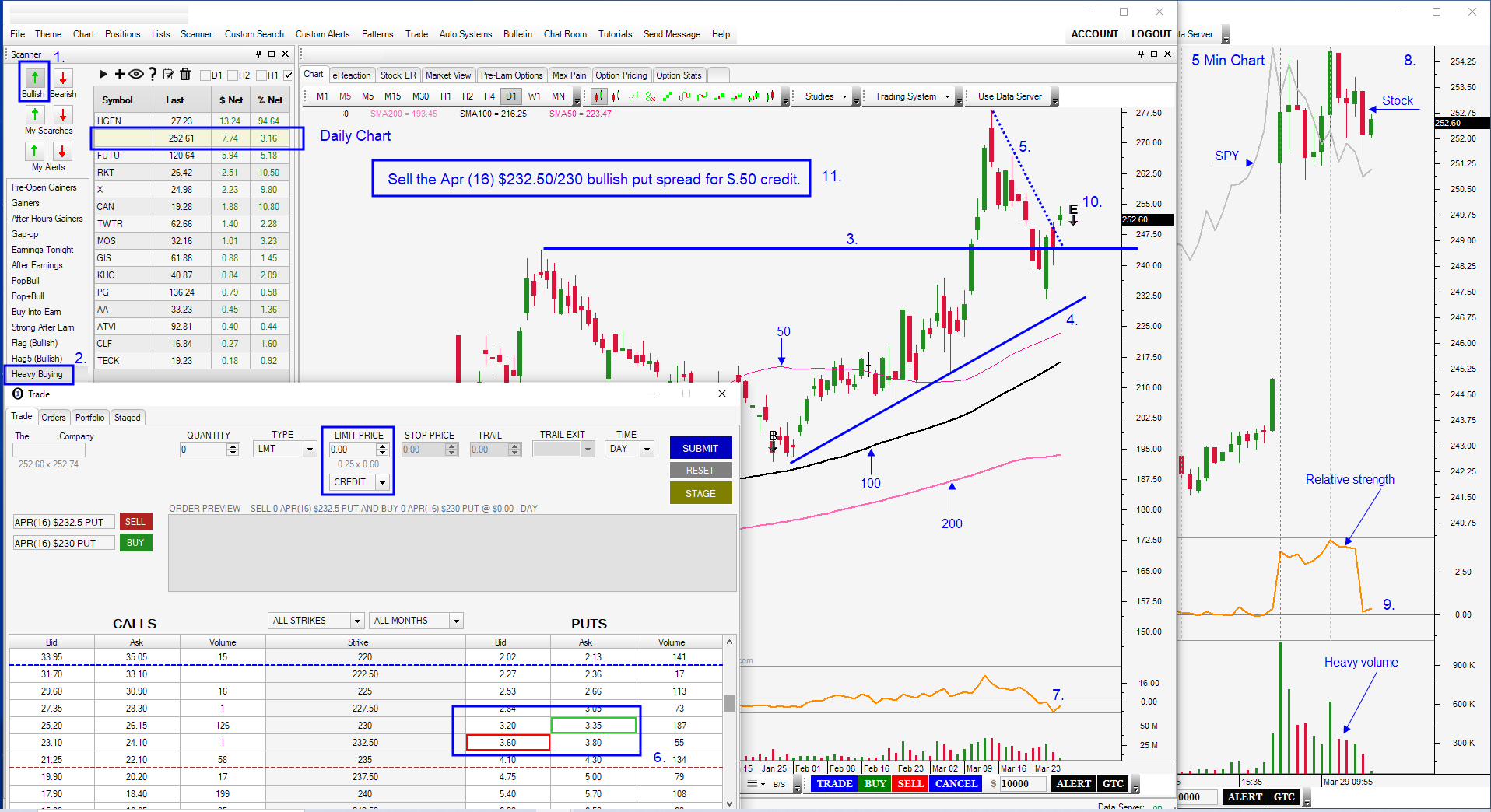In today’s option trading blog I’ll field a question that was forwarded to me by my friends at TradeKing. They have an extensive blog community and it’s a great source of trading information. In the process of answering the question, I’m going to teach you how to save hundreds of dollars (thousands if you’re trading Len Dykstra’s size) when you are getting out of a long option position that is deep in-the-money. Let’s get started.
This excerpt is taken from the middle of an article posted in Fortune Magazine. It describes Mr. Dykstra’s approach to option trading. “All I need is one uptick. I can lose only if there’s an accounting scandal I can’t control,” he says. To illustrate how it works, he sent me trade executions where he bought 100 calls of Anadarko Petroleum (Charts) on Nov. 7, when it was trading at $47.28, with a December $40 strike price. He paid $7.40 a share in order to control 10,000 shares, putting up a total of $74,000. On Nov. 9, when Anadarko bounced to $48.90 a share, Lenny sold his options and made roughly $5,000.
Something was off in the calculation of the profit and one of TradeKing’s customers asked for clarification from the Fortune Editor. This is Andy Kirk’s letter to the Editor: “In your article on Lenny Dykstra, you cite an example of 100 calls trading at $47.28, with a strike price of $40. It cost him $7.40 a share to get control of 10,000 shares, and he sells them later at $48.90. You say he made roughly $5,000. I don’t understand your figures. I have him making $15,000 profit: ($48.90 – $40) x 10,000 = $89,000 – $74,000 = $15,000. What am I doing wrong?”
At this stage, I’m reading along thinking that the Editor would respond to Andy and say that a typo was made and that the stock was actually at $47.90 when Len Dykstra sold the calls. At that level, they would be intrinsically worth $7.90 (the stock price of $47.90 less the strike price of $40) and a half a point profit times 10,000 shares would make $5000. After-all, Len himself states he’s only looking for an uptick. That’s not what Andy heard back.
Here’s the Editors response: “You’re measuring the gain in the stock price, not the gain in the options price. Dykstra never owned the stock itself, because he never exercised the options; he traded them, like stock. Dykstra purchased 100 Anadarko options for $74,000. When the stock price increased, so did the options price, but by a lesser amount, and he sold them for a profit of roughly $5,000.”
Oh boy! That was a rather flippant, spontaneous response and the Editor is not giving his reader much credibility. He answered the question without even thinking about it. At a glance, any option trader could see that there was a mistake. If the stock was truly trading at $48.90, there is NO WAY Len would have been filled at $7.90. The auto quote systems used by Market Maker firms are set up so that they move in tandem with the underlying stock. In this case, the firm’s proprietary algorithms would identify how many shares could be immediately executed at a particular price and they would establish a bid on the calls just under that price. As the bid and bid size of the stock changes, the auto quote adjusts. On deep front month options here’s how it works. Let’s say that the bid/ask on the stock is $48.90, x $48.95 for 1000 shares on both sides. The auto quote option bid/ask will be somewhere below and above that market, let’s say $8.80 x $9.00. If there are 50,000 shares of stock bid at $48.85, the auto quote will be bid for size at $8.80 and here’s why.
As soon as Len would enter his order to sell 100 of the Dec 40 calls, he would get filled at $8.80. In an instant, the proprietary Market Making firm would electronically hit the stock bids and sell the stock. They would sell 1000 shares at $48.90 and 9000 shares at $48.85. They don’t have to wait for an uptick to sell the stock because they are long the calls with the intent to exercise them. Here’s what they would make. Through exercise they bought 10,000 shares at $40 and they sold 1000 shares at $48.90 and they sold 9000 shares at $48.85. They paid $8.80 for the calls so their P&L looks like this. 1000 x 8.90 plus 9000 x $8.85 less 10000 x $8.80 (100 contracts equals 100 shares). They made $100 plus $450 or $550 in an instant. This my friends is called arbitrage and it is what Market Maker firms do. In reality, there’s a chance that if they felt they were able to sell the stock short on an uptick, they would “work” the stock sell orders and not exercise their calls. The reason for this is that they have virtually a risk free position (the stock is $8.00+ in-the-money) and they can collect credit interest on the proceeds of the short stock sale. Before you get too excited, retail customers do not collect credit interest on short sale proceeds. It’s not offered by brokerage firms unless you are a HUGE trader. The short stock long call position also assumes that there is not a dividend due over the holding period.
The bottom-line is that the Editor should have read the question and given his response due deliberation. Hey, we all make mistakes and I’ve found Fortune to be a good read. Here’s why his rationale was inaccurate. Only in an instance where someone is holding an deep in-the money option that is priced with a lot of time premium can the delta of the position be less than 1. The options were already trading at parity ($47.28 less $40.00 = $7.28 and he paid $7.40) and it is unlikely that condition changed on an oil stock during the 2 days the position was held. If the condition did change, the implied volatility was already at zero and it could only go up, making the options worth even more. If the option didn’t move point-for-point it would have set up an arbitrage situation. The whole world would have bought the calls from Mr. Dykstra at $7.90 and sold the stock for $48.85.
Who took Mr. Dykstra’s money? No one. If he made $5000, the stock was at $47.90 and Andy was spot on in noticing the typo.
This brings me to my next point. How can you get the most out of an in-the-money long option position going into expiration? Let’s use the example above. First of all, always remember two things: 1. The stock is much more liquid than the option. 2. The option gives the holder the right to exercise. In this particular case, your first action is to sell 1000 shares of stock at $48.90. The next step is to consider that there are 50,000 shares bid at $48.85. There are many more shares bid than the 9000 you have left. Place an order to sell another 1000 shares at $48.90 and keep entering the orders until you are filled. If the $48.85 bid starts to disappear, hit it. Let’s say that you get all of your shares filled at $48.90. That is effectively the same as selling the calls for $8.90 – a dime better than the $8.80 bid. On 100 contracts, that’s an extra $1000. In Len Dykstra’s case, I hope he knows this trick. He is giving up too much of an “edge” if he sells the calls to the Market Makers. I don’t know about you, but I have no need to line their pockets.
There are a couple of other items left. You need to contact your broker ahead of time to discuss getting out of the trade and to find out how the situation is handled at their particular firm. It is standard that they take the exercise notice and make you long the corresponding number of shares in the account. In doing so you can sell the shares without an uptick. This whole process is recognized by the exchanges and the OCC as a sort-exempt transaction because you are effectively long the shares of stock. You must make sure you sell the stock because the brokerage firm will enter your exercise request and you will come in long shares the next day. You will also have a giant margin requirement. If you do this all the same day, it is called a “same day substitution” and you don’t have to meet the stock margin requirement. The second point is that you will have an extra commission since you are selling stock and exercising an option. Big deal! Have you seen TradeKing’s commissions? If you sold 1000 shares at a time it would cost you an extra $49.50 (10 x $4.95) to make $1000.
If you want to look at this exit method using another example, read, “Avoid the Option Expiration Rip Off”.
As always, please share your comments.









